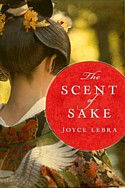|
The Scent of Sakeby Joyce LebraReviewed by Margaret Donsbach Rie's life is defined by contradictions. Women are forbidden to enter the brewing rooms lest their presence sour the sake, yet as her parents' one surviving child, she is the heir to the business. Great care is taken over her marriage, because her husband will inherit her father's position as owner and manager of the brewery, but the man chosen quickly proves to be a drunkard with little business sense who neglects his duties and spends the brewery's funds on geishas. Subtly but firmly, Rie begins to exert a guiding hand. The initial decision condemning Rie to a loveless marriage in the interest of the brewery leads to a chain of consequences that blight the lives of successive generations. Rie, too, as she grows older, makes decisions that favor the brewery over love and compassion. She often recalls her mother's words, "To survive one must kill the self." But although Rie is a survivor, she is no slave to tradition. Masterfully evoking the culture of old Japan, as much in the spare but often lyrical rhythm of its prose as in the details of setting and in the habits, beliefs and mannerisms of its characters, The Scent of Sake is also a testament to the virtue of leavening tradition with change. (2009, 366 pages, plus a "Note to Readers" regarding the historical background) The Scent of Sake is on my "Best Historical Novels I Read in 2009" list. More about The Scent of Sake from Powell's Books
The Teahouse Fire by Ellis Avery (2006), about a woman practitioner of the tea ceremony. More info The Last Concubine by Lesley Downer (2008), about a concubine who falls in love with her rescuer during a period of civil war. More info The Painting by Nina Schuyler (2004), about an unhappily married woman who creates paintings of her lover. More info
Sake: Water from Heaven by Rocky Aoki (2003). More info The Sake Handbook by John Gauntner (2002). More info
The Life of Oharu, a 1952 film by Kenji Mizoguchi based on a tragic seventeenth century Japanese novel about a woman who becomes the lover of a man below her station. More info
Bob Taylor's Brewing Sake website Back to Historical Novels of Asia
|
